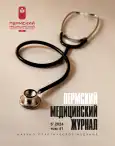Эффективность освоения пациент-ориентированной междисциплинарной модели взаимодействия на примере робот-ассистированных технологий обучения
- Авторы: Байдаров А.А.1, Вронский А.С.2, Лазарьков П.В.3, Асташина Н.Б.4, Шамарина А.М.4
-
Учреждения:
- Пермский национальный исследовательский политехнический университет
- Клинический кардиологический диспансер
- Федеральный центр сердечно-сосудистой хирургии имени С.Г. Суханова
- Пермский государственный медицинский университет имени академика Е.А. Вагнера
- Выпуск: Том 41, № 6 (2024)
- Страницы: 134-140
- Раздел: Методы диагностики и технологии
- URL: https://journal-vniispk.ru/PMJ/article/view/284401
- DOI: https://doi.org/10.17816/pmj416134-140
- ID: 284401
Цитировать
Полный текст
Аннотация
Цель. Оценить эффективность применения человекоподобных роботов для подготовки к аккредитации специалистов и для обучения студентов и врачей медицинского вуза.
Материалы и методы. В проспективном исследовании проанализированы данные двух групп студентов V–VI курсов лечебного и стоматологических факультетов на предмет успешности курации пациентов. Студентам предлагалось провести опрос пациента и установить предварительный диагноз с нозологиями «Ишемическая болезнь сердца» и «Кардиомиопатия Такоцубо». Первая группа проходила обучение по стандартной модели обучения путем курации пациента, вторая группа проходила обучение с использованием робота-симулятора. По окончании курации студентам предлагалось заполнить чек-лист, по которому и проводилась оценка успешности.
Результаты. Выполнить курацию по первому клиническому сценарию удалось в 85 % случаев в группе 1 и в 100 % в группе 2 (p < 0,0001). По второму клиническому сценарию успешная курация в группе 1 состоялась в 11 % случаях и в 100 % случаях в группе 2 (p < 0,0001). При оценке курации согласно чек-листу среднее количество баллов в группе 1 составило 7,3 ± 1,5 балла, в группе 2 – 8,5 ± 1,6 (p < 0,0001).
Выводы. Интеграция робототехнических систем в симулированное обучение увеличивает эффективность преподавательской работы с точки зрения охвата большего числа аспектов различных тем благодаря неоднократному идентичному воспроизведению ситуации.
Полный текст
Открыть статью на сайте журналаОб авторах
А. А. Байдаров
Пермский национальный исследовательский политехнический университет
Email: shamarinaam@gmail.com
ORCID iD: 0000-0003-3888-3358
кандидат технических наук, доцент кафедры автоматики и телемеханики
Россия, ПермьА. С. Вронский
Клинический кардиологический диспансер
Email: shamarinaam@gmail.com
ORCID iD: 0000-0002-0465-8964
кандидат медицинских наук, исполняющий обязанности заведующего кардиохирургическим отделением
Россия, ПермьП. В. Лазарьков
Федеральный центр сердечно-сосудистой хирургии имени С.Г. Суханова
Email: shamarinaam@gmail.com
ORCID iD: 0000-0001-7165-9134
сердечно-сосудистый хирург
Россия, ПермьН. Б. Асташина
Пермский государственный медицинский университет имени академика Е.А. Вагнера
Email: shamarinaam@gmail.com
ORCID iD: 0000-0003-1135-7833
доктор медицинских наук, заведующая кафедрой ортопедической стоматологии
Россия, ПермьА. М. Шамарина
Пермский государственный медицинский университет имени академика Е.А. Вагнера
Автор, ответственный за переписку.
Email: shamarinaam@gmail.com
ORCID iD: 0009-0007-7379-3936
врач-ординатор
Россия, ПермьСписок литературы
- Taber J.M., Leyva B., Persoskie A. Why do People Avoid Medical Care? A Qualitative Study Using National Data. J. Gen. Intern. Med. 2015; 30 (3): 290–297. doi: 10.1007/s11606-014-3089-1
- Wang L., Zhou Y.H., Chiao B.J.M. Robots and firm innovation: evidence from Chinese manufacturing. J. Bus. Res. 2023; 162: 113878. doi: 10.1016/j.jbusres.2023.113878
- Pizam A., Ozturk A.B., Balderas-Cejudo A., Buhalis D., Fuchs G., Hara T., Chaulagain S. Factors affecting hotel managers’ intentions to adopt robotic technologies: a global study. Int. J. Hospit. Manag. 2022; 102: 103139. DOI: 10.1016/ j.ijhm.2022.103139
- Sarah E. Adkins, Dylan T. Vance, Katelyn Sanner Dixon, Jalee Birney, Joshua Lawton, Tyler Elmendorf, Benjamin Stone, German Berbel, Lyndsey J. Kilgore, Making surgical education intuitive: A surgical robotics primer for pre-clinical medical students. The American Journal of Surgery 2025; 239: 116057. doi: 10.1016/j.amjsurg.2024.116057
- Байдаров А.А., Асташина Н.Б., Валиахметова К.Р., Лазарьков П.В., Шамарина А.М. Отработка навыков оказания помощи при неотложных состояниях у врачей стоматологов с использованием антропоморфных симуляционных роботов. Виртуальные технологии в медицине 2024; 3 (41): 312–313. doi: 10.46594/2687-0037_2024_ 3_1973 / Baidarov A.A., Astashina N.B., Valiakhmetova K.R., Lazarkov P.V., Shamarina A.M. Practicing the skills of providing emergency care to dentists using anthropomorphic simulation robots. Virtual technologies in medicine 2024; 3 (41): 312–313. doi: 10.46594/2687-0037_2024_3_1973 (in Russian).
- Patel Saumil J., Notarianni Andrew P., Archer Kilbourne Martin, Albert Tsai, Pulton Danielle A., Linganna Regina E., Sai Bhatte, Mario Montealegre-Gallegos, Bhoumesh Patel, Nathan H. Waldron, Sindhuja R. Nimma, Perin Kothari, Larissa Kiwakyou, Sean M. Baskin, Jared W. Feinman. The Year in Graduate Medical Education: Selected Highlights from 2023. Journal of Cardiothoracic and Vascular Anesthesia 2024; 5: 1053–0770. doi: 10.1053/j.jvca.2024.05.003
- Байдаров А.А., Вронский А.С., Кабирова Ю.А., Лазарьков П.В., Шамарина А.М., Рудин В.В. Использование робот-ассистированных технологий при подготовке к прохождению аккредитации специалистов. Виртуальные технологии в медицине 2023; 3 (37): 303–304. doi: 10.46594/2687-0037_2023_3_1758 / Baidarov A.A., Vronsky A.S., Kabirova Yu.A., Lazarkov P.V., Shamarina A.M., Rudin V.V. The use of robot-assisted technologies in preparation for the accreditation of specialists. Virtual technologies in medicine 2023; 3 (37): 303–304. doi: 10.46594/2687-0037_2023_3_1758 (in Russian).
Дополнительные файлы






